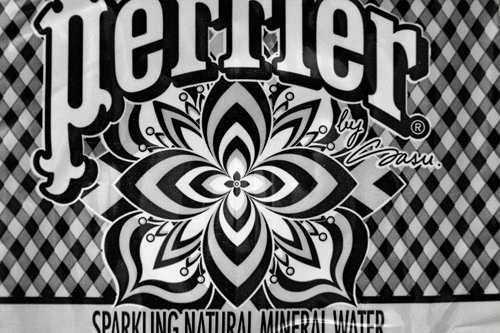
Street art in Paris is increasingly approachable, if not palatable—even potable. Someone had left a can of Dr. Pepper in front of Ender’s brooding angel (in my previous post), as a votive without any motive. “For 150 years,” according to the wrinkly plastic label around the beverage I bought last December, “the Perrier® bottle has come to life under the hands of the most famous artists the world over. In 2014, Perrier® lets you discover nine unique, limited edition creations by three of the community’s most influential and dynamic street artists: the American JonOne, Sasu from Japan, and Kobra from Brazil. Get behind the scenes of the limited edition on Facebook.com/Perrier.” Sadly, Sasu’s erotic, kaleidoscopic orchids, larger than life in their beautiful paroxysms of indigo, lavender, aqueous blue, wilt when uprooted from urban soil and transplanted to the slope of a fizzy drink.
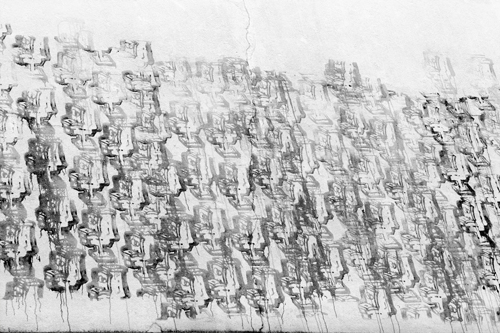
To its credit, Underground Paris acknowledges that, “to some,” their tours are “a controversial and exploitative way to make money out of this populaire artform.” To the extent that populaire still means unremunerated, illegal, amateur slash pop culture, practiced by a disenfranchised, lower than lower middle-class populace, they’re right to note the objection. They earned $15 from each of us who’d reserved in advance, $20 from those who paid on the spot. On the other hand, the monies are funneled to advancing an ongoing project to document Paris street art—a good cause, not to mention a daily endeavor, and one already providing informative pathways for curious learners like me online. One of the artists we looked at, Chiot, might be said to exemplify this fundamental ambivalence (while mirroring my own). By mimicking excretion—his name hails from les chiottes, “the toilets,” or more colloquially, “the shit house”—he critiques the modes of mass production, but only by repeating them. His rubber stamp is an intervention, then a pattern, a wallpaper print.
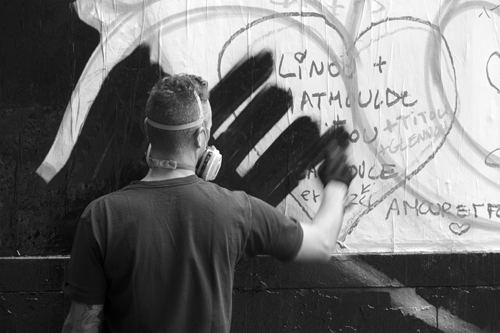
What’s more, their caution is arguably unnecessary, insofar as the majority of the artwork they’re making accessible to the public has itself already, to an implicit degree, made peace with the forces of money, or with local government anyhow, with whom its complicity, if nothing else, is an expedient form of survival. I gather that street art has secured its future, at least in these neighborhoods and for the time being, largely at graffiti’s expense. It can’t be coincidence that one sees so much of the former and, by comparison, so little of the latter along the lowest 2.10 meters of 20me wall—that’s the surface area the city is responsible for cleaning. (Above that, a building’s private owner is on the hook.) I think they think the tourists think the street art is prettier, and that if paint is going to fly one way or another, better it be stencil and tile than tags and showy throwies. At the end of our three-hour tour, the group returned to La Place Verte, where the walk had started at 11 a.m., to see what Monsieur Plume had made in the meantime of his messy morning overtures. He was the latest guest in a string of graffeurs invited by the association Le M.U.R.—the word means “wall,” while the acronym signals Association Modulable, Urbain, Réactif—to paint a mural measuring 3 x 8 meters on the corner of la rue St Maur and la rue Oberkampf. Founded in 2003, Le M.U.R. has been promoting the production and appreciation of street art, at venues all across the city, as a kind of “open-air museum.” Its partners include the city mayoral office and the mayor of the 11th arrondissement, the Pompidou Center, the Cartier Foundation, the Rock en Seine music festival, the street art offshoot of cultural television giant Canal+, the Photograff Collectif, and the magazine GraffitiArt.
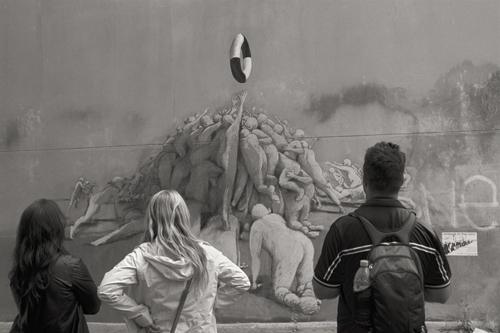
Despite our guide’s hospitality, energy, and facts at the proverbial fingertips, if I had a bone to pick it was with the tour’s evasion of its stated mission: “as much as the people who join our street art tours in Paris want just to see street art, and not look at tags, usually they come with very little a priori knowledge of street art, nor graffiti,” the website explains, “and so, this is why we feel it’s so important that we give the whole story on the street art movement, and not shrug off the graffiti tagging. Reason: Banksy may be as famous today as Andy Warhol, but he started out graffiti tagging.” This reminded me of T.S. Eliot’s assertion that free verse was incomprehensible without a training in classical meter, since a ghost of the earlier always haunts the later, but the tour didn’t stick to its guns. On the contrary, when passing over la Petite Ceinture, a semi-secluded training ground for taggers, our guide pointed out graffiti below, in the tunnel under the bridge, but left it at that. The notion that becoming familiar with street art “means understanding graffiti tagging, even if it’s what people often fear and find unattractive, while usually knowing very little about its stylistic conventions or the culture,” had apparently ceded to that very revulsion. I asked the guide about the aerosol 3ne to the lower right of Philippe Hérard’s scrum of doughy humans—or corpses piled on a mass grave, maybe—scrambling to reach a buoy. Three in one, is that what it said, as if the o had opened, locketlike, to let the others in? The inscription flanked a xeroxed flyer announcing a meeting to combat Unemployment and Precarity. “Peu importe,” the guy said, dismissively, “ça, c’est juste un tag.”
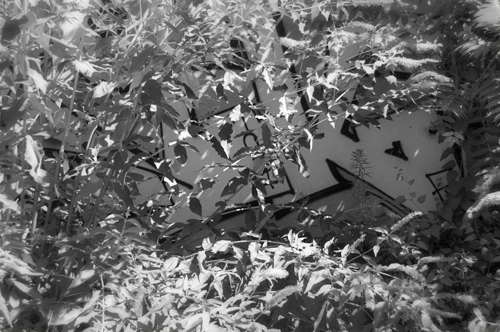
Andrew Zawacki is the author of five books of poetry: Unsun : f/11 (2019), Videotape (2013), Petals ...
Read Full Biography

